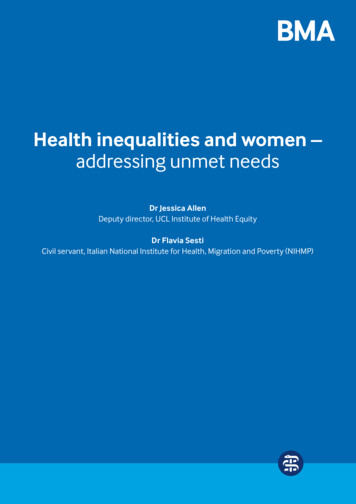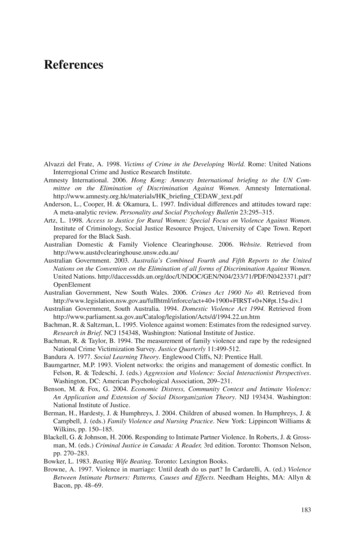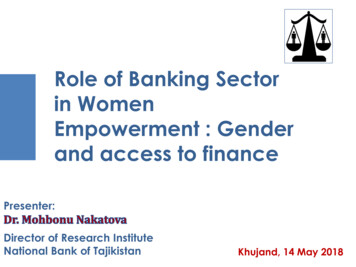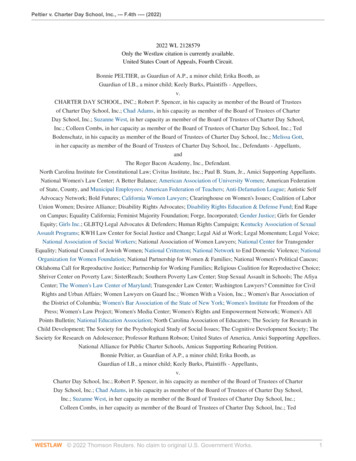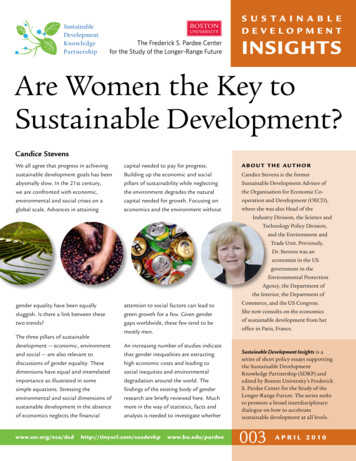
Transcription
s u s ta i n a b l edevelopmentInsightsAre Women the Key toSustainable Development?Candice StevensWe all agree that progress in achievingsustainable development goals has beenabysmally slow. In the 21st century,we are confronted with economic,environmental and social crises on aglobal scale. Advances in attainingcapital needed to pay for progress.Building up the economic and socialpillars of sustainability while neglectingthe environment degrades the naturalcapital needed for growth. Focusing oneconomics and the environment withoutAbout the authorCandice Stevens is the formerSustainable Development Advisor ofthe Organisation for Economic Cooperation and Development (OECD),where she was also Head of theIndustry Division, the Science andTechnology Policy Division,and the Environment andTrade Unit. Previously,Dr. Stevens was aneconomist in the USgovernment in theEnvironmental ProtectionAgency, the Department ofthe Interior, the Department ofgender equality have been equallysluggish. Is there a link between thesetwo trends?The three pillars of sustainabledevelopment — economic, environmentand social — are also relevant todiscussions of gender equality. Thesedimensions have equal and interrelatedimportance as illustrated in somesimple equations. Stressing theenvironmental and social dimensions ofsustainable development in the absenceof economics neglects the financialwww.un.org/esa/dsdattention to social factors can lead togreen growth for a few. Given gendergaps worldwide, these few tend to bemostly men.An increasing number of studies indicatethat gender inequalities are extractinghigh economic costs and leading tosocial inequities and environmentaldegradation around the world. Thefindings of the existing body of genderresearch are briefly reviewed here. Muchmore in the way of statistics, facts andanalysis is needed to investigate eCommerce, and the US Congress.She now consults on the economicsof sustainable development from heroffice in Paris, France.Sustainable Development Insights is aseries of short policy essays supportingthe Sustainable DevelopmentKnowledge Partnership (SDKP) andedited by Boston University’s FrederickS. Pardee Center for the Study of theLonger-Range Future. The series seeksto promote a broad interdisciplinarydialogue on how to acceleratesustainable development at all levels.003april 2010
Are Women the Key to Sustainable Development?gender equity is the “missing link” ofsustainable development.First Pillar:The Economics of GenderThe economic crisis has led toheightened criticisms of the capitalistmodel, where growth is fueled bycompetition and the quest for profits.A lack of corporate responsibilityamong financial institutions — in theUnited States and banks worldwide— brought economic collapseand a recession that has touchedalmost all countries. It may not bea coincidence that this economicmodel has been built largely on theambitions and perspectives of men.As one female leader hypothesized,“If Lehman Brothers had beenLehman Sisters, we would not be inthis economic mess.”The management and boards ofall the failed banks and financialinstitutions are nearly 100 percentmale leading some to blame ourcurrent economic problems on thein all countries. And very few womenreach the top ranks of businessand management. This is variouslyascribed to traditional attitudes, theglass ceiling or the old boys’ network.It may be due more to aninstitutionalized form of genderdiscrimination embedded in thefailure to adjust the male work modelto fit the needs of women. All overthe world, women bear most ofthe responsibility for children andhouseholds and thus suffer from timepoverty and lack of mobility. Theytend to drop out of the labor forceto have children at the same timemen are climbing to the top. Theythen return at an older age and oftenpeak later than men owing to greaterfamily responsibilities. Women havea different career trajectory than menand also need to work flexible hoursand schedules to accommodate theheavy demands on their time.The biggest problem for workingwomen is lack of adequate childcare.For women who work and have“ Why is it that women do not participate in the labor force to thesame extent as men and, when they do, earn 18 percent less?”gender gap. Even in 2010, highlypaid men are to receive large bankbonuses while lower-paid womencontinue to suffer the consequencesof the crisis. Why is it that women donot participate in the labor force tothe same extent as men and, whenthey do, earn 18 percent less? About60 percent of eligible women work inthe richer nations and 40 percent inthe poorer, but this work — whetherformal or informal — is undervalued2s u s ta i n a b l e d e v e l o p m e n t i n s i g h t schildren, appropriate and affordablechildcare options need to be inplace. Countries with governmentfunded childcare and mandatedfamily-oriented practices such as theNordics (Denmark, Finland, Iceland,Norway and Sweden) and Francehave both more working womenand higher birth rates than thosewithout enlightened gender policiessuch as Japan and Korea. It is thelatter countries which most need 003 april 2010women workers to boost growth andproductivity as well as more babiesto counter their ageing populationsand provide a future labor force andfinancial security. Helping womenachieve more work/life balance is theanswer to both their economic slumpand their skewed demographics.Although the female presence inthe workplace is growing, womendo not yet share in economic andpolitical leadership. Among Fortune500 companies, women are onlythree percent of CEOs, six percentof top managers and 15 percent ofboard members. Studies by Catalyst,McKinsey and other groups indicatethat firms with more women inleadership positions tend to havebetter performance and higherprofits. But women remain on thesidelines even though their “risksmart” approaches, people skillsand leadership strengths are sorelyneeded in business and government.The corporate world is slowlyawakening to the economic benefitsof more gender equity. The GlobalReporting Initiative (GRI) nowincludes a guide for gender reportingby firms with the aim of improvingcorporate management and creatingnew business opportunities. Boththe UN Global Compact and theOECD Guidelines for MultinationalEnterprises are exploring theaddition of guiding principles ongender for the corporate sector.Such prescriptions would go beyondequal employment opportunityand human rights to recommendspecific corporate practices targetedto women including flexible workarrangements, child care, careerdevelopment, equal pay, andemployment in non-traditional jobs.
The private sector may need notonly a set of tools for assessing theirbehavior and progress on genderequity but also a compelling driverfor change. Because there are signsassuring the welfare of households.The World Bank publishes regularassessments and a newsletter underthe banner “Gender Equality asSmart Economics” to underline that“ United Nations and World Bank studies show that focusing onwomen in development assistance and poverty reduction strategiesleads to faster economic growth than ‘gender neutral’ approaches.”that gender trends may not changeunassisted, more governments areproposing quantitative targets andquotas for corporations with regardto hiring and promoting women.Since 2003, Norway has requiredcorporate boards to be at least 40percent women and the country nowleads the world in the number offemale directors. Norway also hasquotas for the number of womenmanagers in government at all levels.The French government has recentlyproposed that at least half of allcompany board members must befemale within five years.The economic situation of womenin developing countries is far worse,but the solution is not that different:let women manage the money.Seventy percent of the world’s 1.3billion people living on less than US 1 a day are women or girls. UnitedNations and World Bank studiesshow that focusing on women indevelopment assistance and povertyreduction strategies leads to fastereconomic growth than “genderneutral” approaches. Financial aidput in the hands of men tends to leadto a higher share wasted on personaluse. Women are essential to povertyreduction because of their role inincreasing economic opportunitiesfor women is the cornerstone ofdevelopment.Investing in women and girls — intheir education, health and gainfulactivities — can have a multipliereffect on poor economies. However,the share of bilateral and multilateralaid focused on gender-specificprojects remains insufficient, about30 percent. Banks and donors needto see women as active players ineconomic development. More aidshould be focused on increasingincome-generating initiatives basedon women’s traditional roles in thehome, health services, nutrition,and agriculture. Gender-sensitivedevelopment assistance can be aSecond Pillar:Society and GenderAlthough economists are now goingbeyond GDP to more inclusivemeasures of well-being, money isessential to both ecological andsocial progress. It is how thatmoney is distributed and usedthat determines sustainability. Thesustainable development vision ofGro Harlem Brundtland, the femaleformer Norwegian Prime Ministerwho headed the Commission thatprepared the first sustainabledevelopment report Our CommonFuture in 1987, can be interpreted as“Don’t take more than your share!”This equity tenet applies to money,natural resources and welfare,whether now or in the future.The social pillar of sustainabledevelopment — and its emphasis onequity and equality — is the mostpolitically-sensitive of the threedimensions and thus the hardestto address. It involves confrontingnegative social trends such asgrowing income disparities, risingunemployment, and a persistentgender gap. In response to theeconomic crisis, many countries are“ Gender-sensitive development assistance can be a powerful forcefor empowering women to compete in land, labor and productmarkets enabling them to make economic, social and environmentalcontributions to sustainable development.”powerful force for empoweringwomen to compete in land, laborand product markets enablingthem to make economic, social andenvironmental contributions tosustainable development.implementing strategies for greengrowth, green economies and greenjobs to put them on a lower-carbontrajectory. But if they ignore basicsocial requirements such as incomes u s ta i n a b l e d e v e l o p m e n t i n s i g h t s 003 april 20103
Are Women the Key to Sustainable Development?equity, job quality and genderequality, these initiatives will fail tobe fully sustainable. Unless they areaddressed head-on, social concernswill continue to block progresson economic and ecological aimsand the overall achievement ofsustainable development.Women Workers in the Green EconomyGovernments in Europe, North America and Asia kick-started thegreen economy through the environmental components of their 2009stimulus packages. They pledged US 2 trillion in spending to preventa full-fledged depression, and 24 percent or about US 500 billion is togo to green projects. Renewable energy, transport infrastructure, autocompanies, and green buildings and factories are receiving an infusion ofpublic money. But this green growth may exacerbate social sustainabilityin ignoring widening income and gender gaps.The most dire trend of the currentera is the widening gap between richand poor both within and acrosscountries. The 2008 SustainableSociety Index, which combineseconomic, environmental and socialindicators to compare countryperformance, puts the UnitedKingdom at 50th and the UnitedStates at 66th place. Their lowstanding is due largely to risingpoverty levels. The two countrieshave among the fastest growingdivides between rich and poor inthe OECD area. Unfortunately, it issingle mothers who are the poorestmembers of these rich societiesand many have lost their jobs andhomes in the economic crisis. Greengrowth does not compensate forincome disparities in the sustainabledevelopment equation.A similar story is told by the GenderGap Index of the World EconomicForum, which compares howcountries divide their resources andopportunities among their male andfemale populations. This Index showsIt is expected that 50 million green jobs will be created worldwide in thenext 20 years. About 75 percent of these jobs will be related to renewableenergy and green buildings. Women have long been marginalized in theenergy sector where they are less than six percent of technical staff andbelow one percent of top managers. Women hold less than nine percentof construction jobs. In March 2010, US Labor Secretary Hilda Solischaracterized all green jobs as “non-traditional” for females, therebyqualifying women for green training through the 1992 Womenin Apprenticeship and Nontraditional Occupations (WANTO) Act.It is the responsibility of governments to make the green economysustainable by giving preference to women and other disadvantagedgroups. Otherwise, going green will perpetuate the dominance andperspectives of wealthier males in major economic sectors. Greenstimulus spending and green public procurement should includequotas requiring employers to hire and train women. Funding fornon-traditional training and apprenticeships should include targetsfor female participation. To allow women to join the green economy,governments should mandate industry to adopt family-friendly practicesincluding child care, flexible work and extended leave. And they shouldstrengthen enforcement of the anti-discrimination laws already in place.Source: Green Jobs and Women Workers: Employment, Equity, Equality, Draft Report byCandice Stevens for SustainLabour, 2009.can improve the status of women, acountry cannot advance if its womenare left behind. As might be expected,“ . anti-poverty strategies need to consider the role of socialinstitutions and culture in limiting the access of women toemployment, inheritance and finance.”a correlation between gender equalityand wealth per capita which cutstwo ways: while economic progress4s u s ta i n a b l e d e v e l o p m e n t i n s i g h t sthe highest gender scores are inIceland and Finland and the lowest inChad and Yemen. But there are some 003 april 2010unexpected findings. Several richcountries lag behind poorer countrieswhen the gender markers areeconomic participation, education,health and political empowerment.For example, the United States trailsat 31st place (out of 128 countries)behind South Africa (6) and thePhilippines (9). Japan and Korea,champions of green growth, seriouslylag in the gender stakes at places 75and 115, respectively.
Another composite measuretracking gender discrimination seeksto uncover why women in poorercountries fail to make economicand social progress. The OECDSocial Institutions and GenderIndex (SIGI) evaluates variableseducational outcomes. According toOECD studies, poor children born inEurope, particularly in Scandinavia,have the best chance of advancingbeyond the status of their parents. InEurope, this is least true in the UnitedKingdom and Italy. Intergenerational“ The well-being of both girls and boys can be transmitted from onegeneration to the next depending largely on government measuresto redistribute income through taxes, education, health care, andsocial safety nets.”such as family codes, violenceagainst women, civil liberties, andownership rights in 102 developingcountries. Gender scores, whichare not directly correlated withincome, are lowest in South Asia,sub-Saharan Africa, the Middle East,and North Africa. Here, anti-povertystrategies need to consider the roleof social institutions and culturein limiting the access of womento employment, inheritance andfinance. Difficult and wide-rangingreforms are needed to address theunderlying causes of discrimination,including changes to laws governingproperty rights, marriage anddivorce, and inheritance.Reforms are also needed to assuresustainability in the long-term.The well-being of both girls andboys can be transmitted from onegeneration to the next dependinglargely on government measures toredistribute income through taxes,education, health care, and socialsafety nets. Investments in welfareprograms help children to do betterthan their parents. Governmentbenefits are shown to mitigate theinfluence of family background onmobility is also unlikely at presentin the United States. Long-termsustainable development depends toa large degree on good governancepractices that give equal weight tosocial factors.Third Pillar:Environment and GenderLast but certainly not least, surveysin a range of countries are revealing adifference between men and womenin the environmental sphere. OECDstudies of household behavior showthat women are more likely than mento buy recyclable, eco-labeled andenergy-efficient products. Womennow account for some 80 percent ofhousehold purchases in developedcountries, so the question is why thiseco-consciousness hasn’t translatedinto more sustainable consumerchoices. Unfortunately, sustainableproduction is not following directlyfrom higher levels of sustainableconsumption by women.A number of Swedish studieshighlight that women spend moretime than men seeking informationon sustainable consumption andlifestyle alternatives. Females inSweden recycle more and eatorganic foods and purchase greengoods at higher rates. Men, on theother hand, make fewer but moreexpensive purchases of electronicsand automobiles. In Sweden,when it comes to cars, womenfar outnumber men in supportingreductions in vehicle use andincreased options for sustainabletransportation. Another recent studyfound that Japanese women are alsomore concerned than men about theenvironment and are willing to paymore for sustainable products.In North America, a 2009 Earthsensepoll revealed that 80 percent ofadult women believe stronglythat individuals can affect theenvironment but that they personallyare not doing enough. Other USpolls show that over 60 percent ofwomen consumers consider cleanenergy and recycling important tos u s ta i n a b l e d e v e l o p m e n t i n s i g h t s 003 april 20105
Are Women the Key to Sustainable Development?their purchasing decisions. RecentlyKimberly Clark, the world’s largestproducer of tissue products, wascompelled to stop cutting downancient forests by the wrath of femaleconsumers in league with Greenpeacein the “Kleercut” campaign. Moreand more, consumer giants suchas Unilever and Johnson & Johnsonare stressing eco-efficiency inmanufacturing and eco-innovationin their product lines to their mostlyfemale clientele.Women in developing countriesare starting to realize the financialadvantages of eco-markets.According to the Fair TradeFederation, women are increasinglybehind the organization ofcooperatives producing artisanalgoods as well as agricultural productsfrom coffee to chocolate in thequest to enhance their livelihoods,their communities and local ecosystems. Women now account for76 percent of the workers engagedin non-agricultural Fair Tradeproduction, many fabricating craftsfrom local natural resources. InColombia, women coffee growersincreased profits while enhancingthe environmental sustainability ofproduction and community livingstandards by marketing femaleproduced Fair Trade coffee.6s u s ta i n a b l e d e v e l o p m e n t i n s i g h t sIt is far from proven that women aremore environmentally conscientiousthan men as a rule. But womenare more likely than men to beaffected by environmental problemsbecause of their social roles andmore impoverished status in allcountries. Coping with the effectsof climate change and damagefrom extreme weather events suchas storms, floods, and cyclonesto adapt to climate change impacts.After Hurricane Katrina, those withthe least ability to recover werewomen who are still the majority ofthe poor in the United States. In the1991 cyclone disasters in Bangladesh,90 percent of the victims werewomen. In the 2004 Asian tsunami,more than 70 percent of all deathswere women. But in many cases,women are also the key to managing“ According to the Fair Trade Federation, women are increasinglybehind the organization of cooperatives producing artisanal goods aswell as agricultural products from coffee to chocolate in the quest toenhance their livelihoods, their communities and local eco-systems.tends to fall on women who holdtogether families and households.Women in developing countrieswho supply water and fuel forfamilies find this increasinglydifficult as environmental changesnegatively affect resource supply andinfrastructure. Increased costs forenergy, health-care and food causedby the disrupting effects of climatechange disproportionately affectwomen, especially single mothers.Even in richer countries, women arevulnerable because of their lesseraccess to finance and reduced ability 003 april 2010the aftermath of disaster. In India inthe wake of the tsunami, a networkof women’s self-help groups providedfor the practical needs of the localpopulation including water andsanitation, health care and credit.A few polls show that thesevaried gender sensibilities andresponsibilities lead to differentopinions among men and womenon how to deal with climate change.Surveys by GenaNet in Germanyfound that more men than womenfavored technical solutions such asgreater research on bio-fuels, cleancoal and carbon storage. The womensurveyed leaned more towardschanges in consumption patternsand tougher carbon reductiontargets. Polls by the UK Women’sEnvironmental Network foundthat most women do not think thegovernment is doing enough tocombat climate change and faultthe lack of female involvement inenvironmental policy-making.
Because women are still rare inleadership positions, they havelittle power and influence to affectenvironmental policy. Accordingto the Inter-Parliamentary Union(IPU), about 18 percent of legislativeseats worldwide are held by womenand in many countries there are nofemale representatives at all. IPUstudies also show that women ingovernment give greater emphasisthan men to social welfare andecological issues. According tothe UN, when women are wellrepresented on governing bodies,the overall quality of governancetends to rise and levels of corruptionsink. The equal participation ofwomen and men in public life isone of the cornerstones of the1979 United Nations Conventionon the Elimination of All Formsof Discrimination against Women(CEDAW).Similarly, because women areunder-represented in many industrysectors, they are unlikely to get thegreen jobs increasingly on offer.The irony is that women are beingeducated at a higher rate than menThere are now sufficient numbersof qualified women in everyspecialization and area of expertise— from engineers to architects toscientists — to compete with menin the market for green jobs. Butthe majority of green positions areexpected to be in the construction,energy and engineering fields wherewomen are minority workers.Conclusion:Gender and SustainableDevelopmentSimilarly, thousands of green jobs arebeing created in agriculture, forestry,eco-tourism, and other resourcebased sectors in poorer countries,but here women are a marginalizedgroup. According to SustainLabour,women are being excluded from thegreen economy owing to gendersegregated employment patterns anddecision-making roles, we could bemoving faster and more assuredlytowards sustainability in theeconomic, social and environmentalsense. Sustainable development is apolitical concept because it is aboutgood governance, which will be hardto achieve until we get closer togender parity. Research is needed totest the hypothesis that women aremore risk-averse than men and thatwomen leaders would be more aptto follow sustainable developmentpathways. Given the importance ofgender to sustainability, these issuesshould feature more prominently insustainable development discussionsand be highlighted in a 2012 UNConference on SustainabilityDevelopment.“ If women were in more productive and decision-making roles, wecould be moving faster and more assuredly towards sustainabilityin the economic, social and environmental sense. Sustainabledevelopment is a political concept because it is about goodgovernance, which will be hard to achieve until we get closer togender parity.”in many countries and more femalesthan males are obtaining advanceddegrees. In richer countries, thegender concern in education is thepoor performance of boys and men.As indicated by both theory andevidence, the lack of progress ongender equality may be at theheart of the failure to advance onsustainable development. If womenwere in more productive and discrimination. Schemes are neededto recruit women for non-traditionaljobs, train them in green job skills,and ensure equal pay and high laborstandards.s u s ta i n a b l e d e v e l o p m e n t i n s i g h t s 003 april 20107
Are Women the Key to Sustainable Development?References and Further ReadingGlobal Reporting Initiative (GRI). 2009. Embedding Gender in SustainabilityReporting: A Practitioner’s Guide. Amsterdam: GRI. Available at www.globalreporting.org.Hausmann, Ricardo, Laura D. Tyson and Saadia Zahidi. 2009. The Global GenderGap Report 2009. Geneva: World Economic Forum. Available at isation for Economic Co-operation and Development (OECD). 2008.Babies and Bosses: Reconciling Work and Family Life: A Synthesis of Findings for OECDCountries. Paris: OECD. Available at www.oecd.org.Organisation for Economic Co-operation and Development (OECD). 2008.Gender and Sustainable Development: Maximising the Economic, Social and EnvironmentalRole of Women. Paris: OECD. Available at www.oecd.org.Organisation for Economic Co-operation and Development (OECD). 2008.Growing Unequal? Income Distribution and Poverty in OECD Countries. Paris: OECD.Available at www.oecd.org.Organisation for Economic Co-operation and Development (OECD). 2009.Social Institutions and Gender Index (SIGI). Paris: OECD. Available at www.oecd.org.Organisation for Economic Co-operation and Development (OECD). 2010.“A Family Affair: Intergenerational Social Mobility Across OECD Countries,”Chapter 5 in Economic Policy Reforms: Going for Growth 2010. Paris: OECD. Availableat www.oecd.org.Stevens, Candice. 2009. “Europe Leads the World on Sustainability.” In Europe’sWorld, Spring. Available at www.europesworld.org.Stevens, Candice. 2009. Guest Editor. “Special Issue on Gender and SustainableDevelopment.” International Journal of Innovation and Sustainable Development (IJISD)4(2-3).SustainLabour. 2009. Green Jobs and Women Workers: Employment, Equity, Equality.Draft Report for SustainLabour/International Trade Union Confederation(ITUC). Available at www.sustainlabour.org/dmdocuments/en255 2009.pdf.Wittenberg-Cox, Avivah and Alison Maitland. 2008. Why Women Mean Business:Understanding the Emergence of Our Next Economic Revolution. West Sussex, England:John Wiley & Sons, Inc.The World Bank. 2009. Gender Equality as Smart Economics. Washington, DC: TheWorld Bank. Available at www.worldbank.org/gender.van de Kerk, Guert and Arthur R. Manuel. 2008. “A Comprehensive Indexfor a Sustainable Society: The SSI — The Sustainable Society Index.” Journal ofEcological Economics 66(2-3):228-242.Sustainable DevelopmentKnowledge Partnership (SDKP)brings together governments,individuals, institutions, andnetworks engaged in the productionand dissemination of knowledge onsustainable development, includingresearch institutions and sustainabledevelopment expert networks. Itsaim is to organize knowledge onsustainable development and makeit available to policy makers andpractitioners. The Partnershipis supported by the Division forSustainable Development ofthe United Nations. SustainableDevelopment Insights is a contributionof The Frederick S. Pardee Center forthe Study of the Longer-Range Futureat Boston University to the SDKP.The Frederick S. Pardee Center forthe Study of the Longer-RangeFuture at Boston Universityconvenes and conductsinterdisciplinary, policy-relevant, andfuture-oriented research that cancontribute to long-term improvementsin the human condition. Through itsprograms of research, publicationsand events, the Center seeks toidentify, anticipate, and enhancethe long-term potential for humanprogress, in all its various dimensions.Sustainable Development InsightsSeries Editor: Prof. Adil NajamBoston UniversityPardee House67 Bay State RoadBoston, MA 02215 USApardee@bu.edu617-358-4000 (tel.)617-358-4001 (fax)www.bu.edu/pardeeThe views expressed in SustainableDevelopment Insights are strictly thoseof the author(s) and should not be assumedto represent the position of their owninstitutions, of Boston University, of theFrederick S. Pardee Center for the Studyof the Longer-Range Future, or the UnitedNations.
to see women as active players in economic development. More aid should be focused on increasing income-generating initiatives based on women's traditional roles in the home, health services, nutrition, and agriculture. Gender-sensitive development assistance can be a powerful force for empowering women to compete in land, labor





